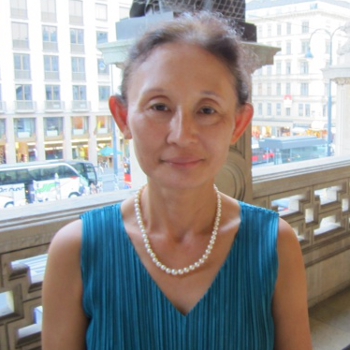The Met’s attempt to replace a 1970 production of Cavalleria rusticana and Pagliacci by Franco Zeffirelli with a new staging by Sir David McVicar was a qualified success. The overall musical performance was good, with the splendid orchestra, led by Fabio Luisi, and the magnificent chorus. While there were some insightful touches in the production that produced intense psychological drama in Cavalleria, the concept was not carried through into Pagliacci, which was more conventional and almost banal.
The two operas shared the same set, a village square surrounded by tall brick walls. A platform on a turntable dominated the floor. As the Cavalleria prelude began, the open stage was bare save for the platform circled by chairs. The chorus, dressed as villagers, entered to take the chair, while Santuzza stood alone on the platform until she finally took a chair. The platform turned frequently throughout the opera, indicating shifts from village square to church to cafe. The focus was squarely on Santuzza, as she never left the stage. She was always observing and reacting to the action, the instigator of the drama of adultery and revenge. Her isolation was again emphasized at the end, when all the villagers turned their back towards her. The stage remained simple, with chairs and a long table the only props. In the church scene, the chorus members carried candles, the only source of light. Everyone was dressed in black. The dark staging effectively enhanced the intensely psychological nature of the opera, with betrayal and revenge.
Eva-Maria Westbroek sang Santuzza with a warm and supple voice large enough to cut through the orchestra. She reigned in her vibrato in high notes, and created a sympathetic character. Even when singing with strong emotion and declamation, her tone never lost its beauty. Her violent duet with her lover Turiddu, who seduced and abandoned her, was one of the highlights of the opera. Other highlights included the splendid Easter Chorus and the prelude and intermezzo played by the orchestra.
Tenor Marcelo Álvarez took on the task of singing the two daunting tenor roles of the double bill. While his robust tenor voice was mostly large, he was able to modulate his voice to produce subtlety and nuance of emotion when needed. The famous aria “Mamma, quell vino e generoso,” was full of tenderness and remorse as he begged his mother to take care of Santuzza. His portrayal of the weak and drunken character who was torn between two women and besieged with remorse was often heartbreaking.
George Gagnidze as Alfio was appropriately brutal and coarse as a village bully. As Mamma Lucia, Jane Bunnell made most of her brief appearance, while Ginger Costa-Jackson was a small voiced but flirtatious Lola.
The theme of Pagliacci was 1940’s Vaudeville. Tonio’s Prologue was sung in front of a curtain of garish electric blue with gold star decorations. Mr Gagnidze sang the difficult aria with panache and style, and was in general stronger as Tonio than as Alfio, his robust voice appropriately menacing.
The village square was now equipped with electricity and telephone wires. The center stage was dominated by a large truck piled high with the luggage and wares of the traveling theater troupe. This forced the action to take place in front stage, and the need to place a large number of chorus members as villagers in the small space created the sense of busy clutter. The humor of a play within the opera was sometimes carried to excess.
Patricia Racette as Nedda, a young frustrated wife of the troupe leader Canio, did not have the vocal sheen and freshness for the role, but made up for the lack of vocal charisma with her fine acting, especially in comical scenes. Andrew Stenson was a sweet voiced Beppe, while Lucas Meachem lacked ardor as Silvio.
As Canio, Álvarez maintained his strong vocal performance without any sign of fatigue. His vocal and physical acting was more generic here than in Cavalleria, perhaps reflecting the more conventional staging, but he sang the signature aria “Vesti la giubba” with appropriate passion and pathos. His drunken rage was quickly replaced by the remorse of having killed his wife and her lover in a fit of jealousy, and he was a pathetic figure in tears on stage at the end.
Perhaps it was the more sweeping and dramatic arc of the music of Cavalleria and the dominance of the orchestra as a major player of the tale, combined with the psychologically focused staging that led to the more successful presentation of Cavalleria. It was a pity that David McVicar chose to treat the two operas as sharing the similar locale but as otherwise completely separate stories, rather than finding common threads.




